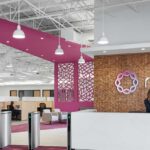Design Matters
It’s not enough to rent a space, get some tables, and call that “enough.” Putting some thought into the design of your office (we can help with office design) is imperative if you’re wanting your employees to produce to their fullest.
The design of your office should reflect both your business goals and your company philosophy.
If you’re wanting, above all else, collaboration, you might consider putting an open-concept layout together in the style of a traditional newsroom (desks in space, allowing for easy, fast collaboration and communication between employees).
If your employees need their privacy – whether because they’re decision makers on company policy or personnel, or because they deal with complex tasks that require focus for long stretches, then you’ll want some spaces where your employees can be alone for significant amounts of time.
Let creatives do their thing
Let creatives be creative!
If you’re wanting the best in terms of creativity, most people seem to work more creatively if they’re allowed to be creative in the context of decor. Let them decorate their own desks (within acceptable limits, of course) – but don’t stymie the creative flow by forcing employees to work in drab surroundings.
Color counts
There are a number of studies which show that the basic color scheme of an office influences how people think. Green, traditionally, is thought to be the most relaxing color (it’s no accident that doctors’ scrubs have traditionally been green!)
Here’s a fantastic infographic from over at Entrepreneur that shows the influences of particular colors:

Cultivate Buzz
There’s actually a measure of privacy in open spaces – so long as there are a number of conversations going on at the same time. If you and a friend walked into a coffee shop and were the only customers talking, you might feel a bit self-conscious – because everyone can hear you and only you.
If that same coffee shop were busy and abuzz with conversations, you’d feel like your conversation was private. After all, everyone’s talking to each other already, and not easily able to hone in on just your conversation.
This plays a role in how you should design your office: open spaces can be private ones too. All it takes is putting enough employees in the same space who need to communicate frequently to perform their job.
Brand your space with objects
Think of a couple of words to describe how you want your space to feel. If those words were, for example, “professional and chic,” then that would imply certain things about how you decorate. You might bring in professionally designed decor with clear, concise lines. You might use white as the primary color for your office.
If your words are “experienced” and “enterprise,” you might use dark wood and items that are appropriately aged if you want to emphasize the level of experience your company brings to the table.
If your words were “fun” and “creative” you might bring in decor that’s playful – gumball machines of different colors, cartoon pictures, etc.
The important thing here is knowing what you want to project, then bringing in decor that emphasizes how you’d like to be perceived.



Leave a Reply